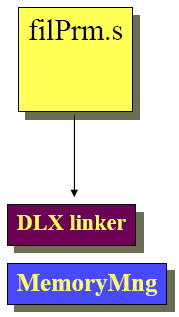Πίσω
 Παράδειγμα 5:
Παράδειγμα 5:
 ΔΡΑΣΤΗΡΙΟΤΗΤΑ
ΔΡΑΣΤΗΡΙΟΤΗΤΑ
- Να εκτελέσετε το πρόγραμμα του παραδείγματος 5 χρησιμοποιώντας τον προσομοιωτή WinDLX.
- Να συγκρίνετε τα αποτελέσματά σας με την απάντηση του παραδείγματος 5.
- Τι εξαρτήσεις δεδομένων παρατηρείτε; Να συγκρίνετε την απάντησή σας με την απάντηση που δίνεται στο παράδειγμα.
Το παράδειγμα που ακολουθεί αναφέρεται σε εξαρτήσεις δεδομένων.
Δίνεται ο παρακάτω κώδικας.
| .data
|
|
| .word
| 2,0,100
|
| .text
|
|
| main:
| lw r1,$DATA(r0)
|
|
| lw r4,$DATA +4(r0)
|
|
| lw r2,$DATA +8(r0)
|
| loop:
| add r4,r4,r2
|
|
| sw $DATA(r0),r4
|
|
| subi r1,r1,#1
|
|
| bnez r1,loop
|
|
| trap #0
|
Εξαρτήσεις δεδομένων μεταξύ του add και sw μέσω του r4 και του subi και bnez μέρω του r1.
Περιπτώσεις:
0x1000:002
intOset:000
intOset:100
0x1000:100
intOset:000
intOset:100
0x1000:200
intOset:000
intOset:100
Παρατηρήσεις:
Τα δεδομένα φορτώνονται στη θέση $DATA (αρχική τιμή 0χ1000).
Ανάλυση:
Αναφορά σε: Εξαρτήσεις δεδομένων
Total:
20 Cycle(s) executed.
ID executed by 12 Instruction(s).
2 Instruction(s) currently in Pipeline.
Harware configuration:
Memory size: 32768 Bytes
faddEX-Stages: 1,required Cycles:2
fmulEX-Stages: 1,required Cycles:5
fdivEX-Stages: 1,required Cycles:19 Forwarding enabled.
Stalls:
RAW stalls: 3 (15.00% of all Cycles), thereof:
LD stalls: 1 (33.00% of RAW stalls)
Branch/Jump stalls: 2 (66.67% of RAW stalls)
Floating point stalls: 0 (00.00% of RAW stalls)
WAW stalls: 0 (00.00% of all Cycles)
Structural stalls: 0 (00.00% of all Cycles)
Control stalls: 1 (5.00% of all Cycles)
Trap stalls: 3 (15.00% of all Cycles)
Total: 7 Stall(s) (35.00% of all Cycles)
Conditional Branches:
Total: 2 (16.67% of all Instructions), thereof:
taken: 1 (50.00% of all cond. Branches)
not taken: 1 (50.00% of all cond. Branches)
Load- / Store-Instructions:
Total: 5 (41.67% of all Instructions), thereof:
Loads: 3 (60.00% of Load-/Store-Instructions)
Stores: 2 (40.00% of Load-/Store-Instructions)
Floating point stage instructions:
Total: 0 (0.00% of all Instructions), thereof:
Additions: 0 (0.00% of Floating point stage inst.)
Multiplications: 0 (0.00% of Floating point stage inst.)
Divisions: 0 (0.00% of Floating point stage inst.)
Traps:
Traps:1 (8.33% of all Instructions)
 Τα στατιστικά αυτά είναι καθοριστικά για την καλύτερη κατανόηση της σωλήνωσης και θα αποτελέσουν πρότυπο για τις επόμενες αναλύσεις.
Τα στατιστικά αυτά είναι καθοριστικά για την καλύτερη κατανόηση της σωλήνωσης και θα αποτελέσουν πρότυπο για τις επόμενες αναλύσεις.
Αναφορά σε: Εξαρτήσεις δεδομένων
 Παράδειγμα 5:
Παράδειγμα 5: Παράδειγμα 5:
Παράδειγμα 5: ΔΡΑΣΤΗΡΙΟΤΗΤΑ
ΔΡΑΣΤΗΡΙΟΤΗΤΑ 
 Τα στατιστικά αυτά είναι καθοριστικά για την καλύτερη κατανόηση της σωλήνωσης και θα αποτελέσουν πρότυπο για τις επόμενες αναλύσεις.
Τα στατιστικά αυτά είναι καθοριστικά για την καλύτερη κατανόηση της σωλήνωσης και θα αποτελέσουν πρότυπο για τις επόμενες αναλύσεις.